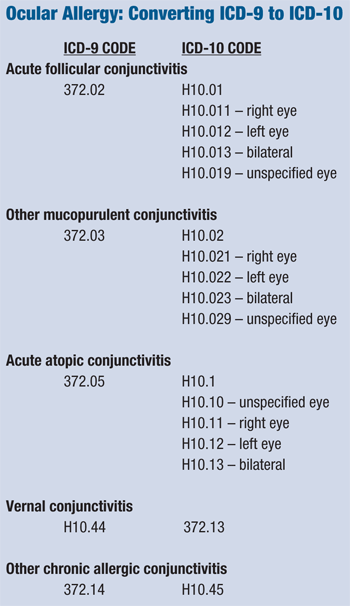Optometrists often don’t recognize how much work they do in the differential diagnosis, clinical tests and medical decision making when treating ocular allergy—and are commensurately undercoding for their intellectual property. Recognize the work that you do, document the medical record appropriately, and then translate accurately from the medical record into the proper CPT code for billing purposes.


The allergy diagnosis would, at first blush, seem to be easy and straightforward; however, other ocular diseases can masquerade as allergy. One of the best diagnostic tools available is a thorough and accurate patient history. The diagnostic testing required to accurately identify allergy, and differentiate it from other ocular disease processes, is often encompassed within the evaluation and management codes or the general ophthalmic evaluation codes.
Assuming the only reason for a visit is the allergy process, the most common evaluation and management code choices are 99203, 99202, 99212 or 99213. The general ophthalmologic service code choices are 92002 or 92012.

Diagnostic tests that might be used for the differentiation include Schirmer’s tear test or phenol red thread tear test, tear film break-up time, vital dye staining evaluation, and slit lamp evaluation with or without lid eversion. All of these tests are included in the office visit code that is appropriate for the visit complexity, and are based upon the medical necessity documented in the medical record.
There is a tear assay test available that might be separately billable. To test IgE level, use radioimmunoassay, such as the Tandem-R immunoradiometric assay. The appropriate CPT code for this assay is 83519 (Immunoassay for analyte other than infectious agent antibody or infectious agent antigen; quantitative, by radioimmunoassay). However, there are very specific rules that you must follow before billing for clinical lab tests within your practice.
There are several common diagnosis codes for allergy under IDC-9. Beginning in October 2013, all providers will have to use the ICD-10 diagnosis codes. (See “Ocular Allergy: Converting ICD-9 to ICD-10”)
While the actual coding for an allergy patient is not complex, be sure that you base your office visit and clinical tests upon the medical necessity of the situation (specific to the patient), and use the appropriate diagnosis. However, also understand that the appropriate diagnosis can be a bit more challenging. Treating ocular allergy, while commonplace, can be very rewarding to your patient, yourself, and your practice. n

